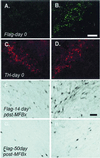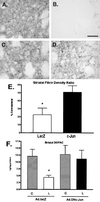c-Jun mediates axotomy-induced dopamine neuron death in vivo
- PMID: 11687617
- PMCID: PMC60880
- DOI: 10.1073/pnas.231177098
c-Jun mediates axotomy-induced dopamine neuron death in vivo
Abstract
Expression of the transcription factor c-Jun is induced in neurons of the central nervous system (CNS) in response to injury. Mechanical transection of the nigrostriatal pathway at the medial forebrain bundle (MFB) results in the delayed retrograde degeneration of the dopamine neurons in the substantia nigra pars compacta (SNc) and induces protracted expression and phosphorylation of c-Jun. However, the role of c-Jun after axotomy of CNS neurons is unclear. Here, we show that adenovirus-mediated expression of a dominant negative form of c-Jun (Ad.c-JunDN) inhibited axotomy-induced dopamine neuron death and attenuated phosphorylation of c-Jun in nigral neurons. Ad.c-JunDN also delayed the degeneration of dopaminergic nigral axons in the striatum after MFB axotomy. Taken together, these findings suggest that activation of c-Jun mediates the loss of dopamine neurons after axotomy injury.
Figures





Similar articles
-
Regulation of axotomy-induced dopaminergic neuron death and c-Jun phosphorylation by targeted inhibition of cdc42 or mixed lineage kinase.J Neurochem. 2006 Jan;96(2):489-99. doi: 10.1111/j.1471-4159.2005.03568.x. Epub 2005 Nov 29. J Neurochem. 2006. PMID: 16336220
-
Axotomy-induced dopaminergic neurodegeneration is accompanied with c-Jun phosphorylation and activation transcription factor 3 expression.Exp Neurol. 2008 Jan;209(1):268-78. doi: 10.1016/j.expneurol.2007.09.033. Epub 2007 Oct 13. Exp Neurol. 2008. PMID: 18036593
-
JunB and Bcl-2 overexpression results in protection against cell death of nigral neurons following axotomy.Brain Res Mol Brain Res. 2002 Aug 15;104(2):194-202. doi: 10.1016/s0169-328x(02)00378-9. Brain Res Mol Brain Res. 2002. PMID: 12225874
-
Activation of the c-Jun transcription factor following neurodegeneration in vivo.Neurosci Lett. 2004 May 6;361(1-3):36-9. doi: 10.1016/j.neulet.2003.12.011. Neurosci Lett. 2004. PMID: 15135887 Review.
-
Role of NGF in axotomy-induced c-Jun expression in medial septal cholinergic neurons.Int J Dev Neurosci. 1998 Nov-Dec;16(7-8):691-703. doi: 10.1016/s0736-5748(98)00079-3. Int J Dev Neurosci. 1998. PMID: 10198817 Review.
Cited by
-
Antiapoptotic and trophic effects of dominant-negative forms of dual leucine zipper kinase in dopamine neurons of the substantia nigra in vivo.J Neurosci. 2008 Jan 16;28(3):672-80. doi: 10.1523/JNEUROSCI.2132-07.2008. J Neurosci. 2008. PMID: 18199767 Free PMC article.
-
Calpain-regulated p35/cdk5 plays a central role in dopaminergic neuron death through modulation of the transcription factor myocyte enhancer factor 2.J Neurosci. 2006 Jan 11;26(2):440-7. doi: 10.1523/JNEUROSCI.2875-05.2006. J Neurosci. 2006. PMID: 16407541 Free PMC article.
-
Assessment of intrinsic and extrinsic signaling pathway in excitotoxic retinal ganglion cell death.Sci Rep. 2018 Mar 15;8(1):4641. doi: 10.1038/s41598-018-22848-y. Sci Rep. 2018. PMID: 29545615 Free PMC article.
-
Hypersensitivity of DJ-1-deficient mice to 1-methyl-4-phenyl-1,2,3,6-tetrahydropyrindine (MPTP) and oxidative stress.Proc Natl Acad Sci U S A. 2005 Apr 5;102(14):5215-20. doi: 10.1073/pnas.0501282102. Epub 2005 Mar 22. Proc Natl Acad Sci U S A. 2005. PMID: 15784737 Free PMC article.
-
Regulation of dopaminergic loss by Fas in a 1-methyl-4-phenyl-1,2,3,6-tetrahydropyridine model of Parkinson's disease.J Neurosci. 2004 Feb 25;24(8):2045-53. doi: 10.1523/JNEUROSCI.4564-03.2004. J Neurosci. 2004. PMID: 14985447 Free PMC article.
References
-
- Herdegen T, Waetzig V. Oncogene. 2001;20:2424–2437. - PubMed
-
- Horner P J, Gage F H. Nature (London) 2000;407:963–970. - PubMed
-
- Park D S, Stefanis L, Greene L A. Trends Cardiovasc Med. 1997;7:294–301. - PubMed
-
- Dragunow M, Young D, Hughes P, MacGibbon G, Lawlor P, Singleton K, Sirimanne E, Beilharz E, Gluckman P. Brain Res Mol Brain Res. 1993;18:347–352. - PubMed
-
- Vaudano E, Rosenblad C, Bjorklund A. Eur J Neurosci. 2001;13:1–14. - PubMed
Publication types
MeSH terms
Substances
LinkOut - more resources
Full Text Sources
Other Literature Sources
Miscellaneous

